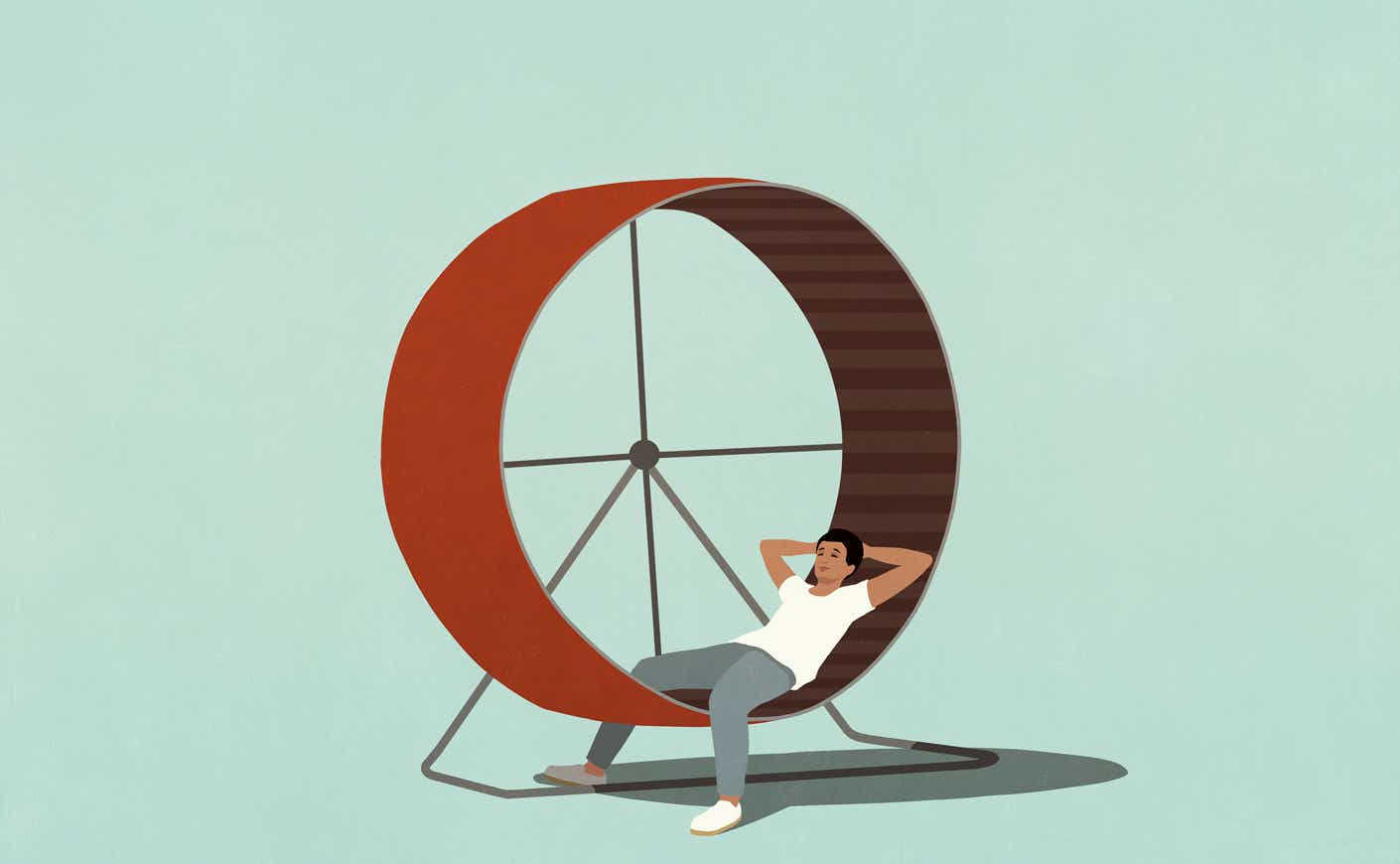Productivity guru Cal Newport is back with a new book on taming busywork and accomplishing more.
Cal Newport knows why we’re all so tired at work.
In his new book, Slow Productivity, the bestselling author and computer science professor argues that white-collar work is deeply flawed — and has been since the first fax was fired off.
The problem, says Newport, is that we still haven’t come up with a clear way to measure productivity in so-called “knowledge work.” Unlike in the agriculture field where you can point to, say, bushels of wheat yielded per acre of land, or manufacturing — where you can count how many Subarus per worker are built on the assembly line — there’s no simple way to gauge how productive a product manager or a HR representative really is. There’s no way to say for certain that spending 15 hours in meetings every week or “hearting” 50 Slack messages a day is actually contributing to a company’s bottom line, Newport tells us.
What’s emerged in lieu of useful metrics is what Newport calls “pseudo-productivity” or an employee’s visible activity. Thirty years ago, this might have meant drafting memos, sitting in on conference calls, and typing a little more vigorously when the boss walked by. Today, it means something else entirely.
“Where this goes wrong is when we introduce email, laptops, smartphones, and Slack,” Newport tells us. “This is when pseudo-productivity goes off the rails, because it’s now possible to demonstrate visible activity at any moment, whether you’re at the office, at home, or at your kid’s soccer game.”
This type of labor is, for one, absolutely exhausting. But it also leads office workers to shy away from the big ambitious projects that may take months or years to develop, in favor of shallower tasks that can be easily ticked off a to-do list, Newport writes.
Slow Productivity is not all handwringing though. Like all of Newport’s past works, the book offers some surprisingly simple ways to reduce some of the busyness of your 9-to-5 and makes a very strong case for why doing so will help you find joy in your job. In this new interview, Newport shares some of his workday hacks, discusses why the quiet quitters were onto something, and much more.
Katie Couric Media: The alternative to pseudo-productivity is what you call slow productivity, which you break down into three major principles.
Newport: Slow productivity has the goal of moving the focus away from activity and toward high-quality output. So what’s evaluated is not what you’re doing right now, but what you did over the year, and what you created that you’re proud of.
The three principles that underscore this shift toward actual output is doing fewer things, working at a more natural pace on those things, and at the same time obsessing over the quality of what you produce. You put those three together and you get slow productivity, which I think is not only a more effective alternative to pseudo-productivity, but is much more sustainable and meaningful for the individual worker.
I think a lot of people would look at a principle like “do fewer things” and say, “Well, that’s not really realistic in my job.” But you’ve outlined some simple tips that most office workers can implement to accomplish this.
The key to understanding doing fewer things is that it’s not the same as accomplishing fewer things. Really what I mean by “do fewer things” is actually do fewer things simultaneously. The reason why this works is because everything you say yes to is gonna come with its own administrative overhead — emails you have to send, Slack chats, meetings related to the thing you agreed to do. So as you say yes to more and more things concurrently, the total amount of administrative overhead increases, and now more and more of your day is spent talking about work, and less of it is spent actually trying to complete the projects. So the rate at which anything gets done actually slows down. When you work on fewer things at the same time, the rate overall in which things are being finished actually increases. Over time, this is something your boss should be happy with.
The question then is, how do we actually make this shift? One idea is differentiating between the small number of things you’re actively working on, and the queue of things you’re waiting to work on. You make this distinction very transparent, so when someone comes to you with a task, you say, “Great, here’s my workload document. At the top are three things I’m working on now and at the bottom are the queue of things that I’m gonna work on next.” At that point they probably realize that you won’t be able to get to this task for a while and maybe they decide your plate’s too full.
If you gain a reputation as someone who’s very careful about their time, you’re gonna gain more trust and flexibility. The expectation that you always respond and do everything right away is an expectation that tends to be put on people who aren’t trusted to be organized and on top of things. That’s where managers start to demand immediate yeses.
One method of doing fewer things that emerged during the pandemic was quiet quitting. What do you think of this trend?
It kind of fizzled out as a movement, because eventually employers said, “”Well we’re not going to hire you if you’re going to keep doing the bare minimum.” But one thing it highlighted is that knowledge workers really do have a lot of control over the busyness of their day. Quiet quitters were able to drastically reduce their busyness by quiet quitting. Now, if you permanently quiet quit, that’ll eventually get noticed and you might lose your job. But what I point out in the book is that if you do this temporarily, it’s probably not gonna be noticed. You can tame your busyness for a while at least and turn it back up again when you want to.
Take advantage of that. Maybe say to yourself, I’ll quiet quit a little bit in December or July, and be careful to not take on new projects or volunteer to do as much. By doing this in a subtle way, you can introduce a more natural seasonality to your work schedule without having to make a big speech about it. You can control your workflow more than you think and you should keep yourself from always being pegged at 100 percent productivity.
Do you think that what you describe as the unnatural pace of knowledge work contributes to burnout?
It’s really unnatural for humans to work at a full level of intensity every day of the work week, with only two weeks off a year. Before we developed mills and factories, humans never worked that way. There’s nothing in our wiring that makes us well-suited for this. Historically, people had way more variation — hard parts of the day, quieter part of the day, seasons that were really intense and seasons where you effectively hibernated. We’re wired for this pattern of recharge and rest, and we produce better under those conditions. We need to find ways to build more variation into our work lives to make knowledge work more sustainable.
You talk about how we have a natural bias toward thinking about productivity in the short term, but that may be at odds with creating quality work.
A lot of us in the modern world think about very short timescales, about being productive this hour. When you look at these really minute timescales it leads us toward busyness, because you want to cram your hour full of stuff. But when you study traditional knowledge workers, people who didn’t work in offices but who used their brains to create value and had a lot of flexibility to experiment all tend to gravitate toward much longer timescales. They gave themselves several years with periods where they’re working on completely unrelated things.
If you look at Marie Curie and her work on radiation, which would eventually win a Nobel Prize, she would still go on multi-month vacations with her family to the French countryside even while honing in on isolating radium from pitchblende. The idea that you need to be working everyday, every month, with no break doesn’t make much sense. The traditional knowledge workers had way more variation day to day and gave themselves way more time to rest and recharge.
What’s a good starting point for people looking to implement slow productivity into their workdays?
You can start directly by trying to do fewer things at once. So, right off the bat, write down all the things you said yes to and figure out what you have to actively work on and what can wait. Immediately move to a pull-style model of work, where you only pull something into your queue after you’ve finished something else. Make this list public and be very transparent about it.
At the same time, you can start thinking about the other side of slow productivity — caring about quality. The more you care about creating something of quality, the more insistent you’ll become about slowing down and being less busy, because busyness is incompatible with quality. And the better you do in whatever concentration you have, the more freedom you’re gonna gain to reduce the busyness from your schedule. So start by identifying what are the things in your work you do best, that’s most valuable and how do I systematically get better at that? You want to come at this from both the highly tactical end of “let me right away reduce my concurrent workload” and also this more philosophical angle of What am I really doing in my job?
This interview has been edited for length and clarity.













